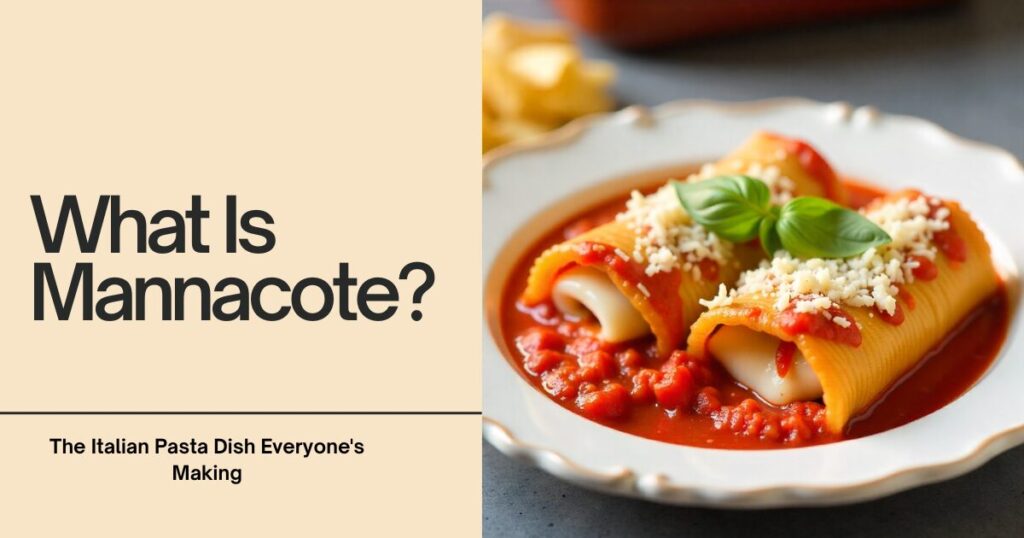
Mannacote is a regional pronunciation of manicotti, the classic Italian-American baked pasta dish. Large pasta tubes get stuffed with creamy ricotta cheese, smothered in marinara sauce, and baked until bubbly and golden.
This dish has been a Sunday dinner staple in Italian-American homes for generations. You’ll find it called “mannacote” in New Jersey, New York, and Pennsylvania—where immigrant families passed down recipes through thick accents and kitchen memories. Whether you spell it mannacote, manicot, or manicotti, you’re talking about the same delicious comfort food that brings families together.
| Quick Facts | Details |
|---|---|
| Also Known As | Manicotti, Manicot, Cannelloni |
| Origin | Italian-American (late 1800s-early 1900s) |
| Main Ingredients | Pasta tubes, ricotta, mozzarella, marinara sauce |
| Cooking Method | Baked at 375°F for 25-30 minutes |
| Prep Time | 30 minutes |
| Cook Time | 30 minutes |
| Serves | 6-8 people (12-14 tubes) |
| Calories per Serving | Approximately 350-450 calories |
The Real Story Behind the Name Mannacote
Mannacote comes from Italian immigrant families who phonetically changed “manicotti” through regional dialects and accents. The word stuck in households across the Northeast United States, passed down through generations who learned recipes by watching Nonna in the kitchen—not reading cookbooks.
In Italian, “manicotti” means “little sleeves” or “muffs,” describing the pasta tubes’ shape. When Italian immigrants arrived in America during the late 19th and early 20th centuries, they brought their culinary traditions but adapted them to available ingredients. Traditional Italian cannelloni required fresh pasta sheets and béchamel sauce, which weren’t easy to find in American markets.
The solution? Pre-formed dry pasta tubes that simplified preparation while maintaining the dish’s essence. The name evolved too—from manicotti to manicot to mannacote, depending on which region and family you asked. These variations reflect how language and food blend to tell cultural stories.
Many Italian-American families still use “mannacote” because that’s what their grandmothers called it. It’s not wrong—it’s tradition. The term carries nostalgia, family history, and the warmth of Sunday dinners where everyone gathered around the table.
How Mannacote Differs from Traditional Manicotti?
Technically, there’s no difference between mannacote and manicotti in terms of ingredients or preparation. Both feature large pasta tubes stuffed with ricotta cheese, covered in sauce, and baked until golden. The only distinction is linguistic and cultural.
Some families call it mannacote because that’s their family tradition. Others use manicotti because that’s what the grocery store box says. The pronunciation varies by region—New Jersey and New York families often say “mannacote,” while cookbook recipes stick with “manicotti.”
The dish differs from Italian cannelloni in a few ways. Cannelloni uses fresh pasta sheets rolled into tubes, while mannacote typically uses pre-formed dried pasta tubes. Italian versions often include béchamel sauce alongside marinara, creating a creamier dish. American-style mannacote focuses on tomato-based sauces with melted mozzarella on top.
Both dishes share the same spirit—stuffed pasta baked in sauce until bubbly. The cultural identity comes from how families prepare and name it, making each version special in its own way.
Essential Ingredients for Perfect Mannacote
You need just a few key ingredients to create delicious mannacote at home. Start with manicotti pasta tubes—one 8-ounce box contains 12-14 tubes, perfect for serving 6-8 people. Look for large, ridged tubes specifically labeled manicotti or cannelloni.
The cheese filling requires 32 ounces of whole milk ricotta cheese. Drain any excess liquid for a firmer texture. Add 2 cups of shredded mozzarella (divided—1.5 cups for filling, 0.5 cup for topping) and 1 cup of grated Parmesan cheese (3/4 cup for filling, 1/4 cup for topping). One large egg binds everything together.
Fresh herbs make the difference between good and great mannacote. Use 1/4 cup finely chopped fresh parsley, 2 tablespoons chopped fresh basil (or 1 teaspoon dried), and 1 teaspoon dried oregano. Add 1 teaspoon garlic powder, 1 teaspoon salt, and 1/2 teaspoon black pepper.
You’ll need 4-5 cups of marinara sauce (32-40 ounces). Homemade tastes fantastic, but good quality jarred sauce works perfectly. Some families add a pinch of nutmeg to the cheese filling—it adds unexpected warmth and depth.
Optional additions include 10 ounces of frozen chopped spinach (thawed and squeezed completely dry), 1 pound of cooked ground beef or Italian sausage, or fresh garlic cloves instead of powder. These variations let you customize the dish to your family’s taste.
Step-by-Step Instructions for Making Mannacote
Preheat your oven to 375°F (190°C). This temperature ensures the pasta cooks through while the cheese melts and browns beautifully on top.
Bring a large pot of salted water to a boil. Carefully add the mannacote tubes and stir gently to prevent sticking. Cook for only 6-7 minutes until al dente—slightly firm to the bite. They’ll soften more during baking. Overcooking now leads to tearing when you stuff them later.
Immediately drain the tubes and rinse under cold water to stop cooking. Lay them in a single layer on clean kitchen towels or parchment paper to dry. Pat the outside lightly—wet pasta makes filling messy.
While pasta cools, make the cheese filling. Combine drained ricotta, 1.5 cups mozzarella, 3/4 cup Parmesan, egg, parsley, basil, oregano, garlic powder, salt, and pepper in a large bowl. If using spinach or meat, fold them in now. Mix until just combined—overmixing makes the filling gummy. Taste and adjust seasoning.
Spread 1-1.5 cups of marinara sauce across the bottom of a 9×13-inch baking dish. This prevents sticking and adds flavor. Use a spoon or piping bag to fill each tube with cheese mixture. Be generous but don’t overstuff, or they’ll burst during baking.
Place filled tubes seam-side down in the baking dish, arranging them snugly in a single layer. Pour remaining sauce over the top, making sure every tube gets covered. Sprinkle with remaining mozzarella and Parmesan.
Cover the dish tightly with aluminum foil. Bake for 20 minutes covered, then remove foil and bake 10 more minutes until cheese melts, browns, and bubbles. Let it rest 5-10 minutes before serving—this helps the filling set.
Creative Variations to Try
Experiment with different cheeses for new flavor profiles. While ricotta and mozzarella are classics, you can add goat cheese or feta for tanginess. Some families use a blend of four cheeses—ricotta, mozzarella, Parmesan, and Romano—for extra richness.
The meat version adds 1 pound of cooked ground beef, Italian sausage, or a combination. Brown the meat with garlic and Italian seasonings, drain excess fat, then mix into the cheese filling. This creates a heartier, more filling dish perfect for cold weather.
Vegetarian options work beautifully. Add 10 ounces of thawed, squeezed-dry spinach to the cheese mixture. Sautéed mushrooms, diced bell peppers, or roasted eggplant also make excellent additions. These vegetables boost nutrition while adding complex flavors.
Switch up the sauce for variety. Traditional marinara is classic, but creamy Alfredo sauce transforms the dish completely. Pesto mixed with cream creates a vibrant green sauce that tastes incredible. Some families do half marinara, half Alfredo for the best of both worlds.
Herbs and spices let you customize further. Add red pepper flakes for heat, fresh thyme for earthiness, or lemon zest for brightness. A pinch of nutmeg in the cheese filling adds warmth that pairs perfectly with tomato sauce.
Best Side Dishes to Serve with Mannacote
Mannacote is a hearty main course that pairs beautifully with lighter sides. Start with a crisp garden salad featuring mixed greens, cherry tomatoes, cucumbers, and red onions. A simple vinaigrette cuts through the richness of cheese and pasta.
Garlic bread is non-negotiable for many families. The buttery, toasty texture complements the soft pasta tubes perfectly. Make it extra special by brushing with garlic butter and sprinkling with Parmesan and parsley before baking.
Roasted vegetables add color and nutrition to your plate. Try zucchini, bell peppers, asparagus, or broccoli tossed with olive oil, salt, and pepper, then roasted at 425°F until caramelized. The vegetables’ slight char balances the creamy cheese filling.
For a complete Italian feast, serve antipasto as an appetizer. Arrange cured meats, marinated vegetables, olives, and cheese on a platter. This gives guests something to nibble while the mannacote bakes and your kitchen fills with incredible aromas.
Caesar salad offers another excellent pairing. The tangy dressing, crunchy romaine, and Parmesan shavings create textural contrast against soft pasta. Add grilled chicken to the salad if you want more protein without making the meal too heavy.
Nutritional Benefits of Mannacote
Mannacote provides substantial nutrition despite being comfort food. The pasta supplies carbohydrates for energy—essential for active lifestyles. One serving gives you approximately 350-450 calories, depending on portion size and ingredients used.
Cheese contributes significant protein and calcium. Ricotta contains about 14 grams of protein per cup, while mozzarella adds more. This protein supports muscle maintenance and keeps you feeling full longer. Calcium strengthens bones and teeth—especially important for growing kids and aging adults.
Adding spinach boosts the dish’s vitamin content dramatically. Spinach provides vitamins A, C, and K, plus iron and folate. These nutrients support immune function, vision, blood clotting, and red blood cell production. Just 10 ounces of spinach transforms mannacote into a more balanced meal.
Tomato sauce delivers lycopene, a powerful antioxidant linked to heart health and reduced cancer risk. Cooking tomatoes actually increases lycopene availability, making marinara sauce more nutritious than raw tomatoes. Garlic and herbs add anti-inflammatory compounds and antibacterial properties.
Make it healthier by using whole grain pasta tubes, low-fat ricotta, and part-skim mozzarella. These swaps reduce calories and saturated fat without sacrificing flavor. Adding vegetables increases fiber, helping with digestion and keeping you satisfied.
People Also Love to Read This: Mariel Cruceta 3476591966
How to Store and Reheat Leftover Mannacote?
Store leftover mannacote in an airtight container in the refrigerator for up to 4 days. Let it cool completely before covering—trapped steam creates excess moisture that makes pasta soggy. Individual portions store well in smaller containers for easy grab-and-go lunches.
Reheat in the oven for best results. Place portions in an oven-safe dish, cover with foil, and bake at 350°F for 20-25 minutes until heated through. Add a splash of water or extra sauce before reheating to prevent drying out. Remove foil for the last 5 minutes to crisp the cheese topping.
Microwave reheating works for quick meals. Place a portion on a microwave-safe plate, cover with a damp paper towel, and heat in 1-minute intervals, checking temperature between each. The paper towel creates steam that keeps pasta moist. Expect 2-3 minutes total for refrigerated leftovers.
Freeze mannacote for longer storage—up to 3 months. Assemble the dish but don’t bake it. Wrap tightly in plastic wrap, then aluminum foil, labeling with the date. Thaw overnight in the refrigerator before baking as directed, adding 10 extra minutes to account for cold temperature.
You can also freeze individual baked portions. Wrap each serving separately for easy single-meal reheating. This method gives you homemade mannacote anytime without committing to a full pan.
Common Mistakes to Avoid
Overcooking the pasta tubes before stuffing ranks as the biggest mistake. Cook them only to al dente—they’ll finish cooking in the oven. Mushy pasta tears when you try to fill it, creating a frustrating mess. Set a timer and test a tube at 6 minutes.
Watery filling ruins mannacote. Always drain ricotta cheese if it looks liquidy. If using spinach, squeeze it completely dry—wrap it in clean kitchen towels and wring hard. Excess moisture makes the filling runny and prevents proper setting during baking.
Skipping the bottom layer of sauce causes sticking. Always spread sauce on the baking dish bottom before adding filled tubes. This creates a non-stick surface and adds flavor. You’ll thank yourself when serving—the tubes lift out cleanly instead of tearing.
Overfilling the tubes makes them burst during baking. Leave about 1/4 inch of space at each end. The filling expands slightly as it heats, and overstuffed tubes split, leaking cheese everywhere. Use restraint even when you’re tempted to pack in more filling.
Not letting the dish rest after baking leads to a sloppy mess. Let mannacote sit 5-10 minutes before serving. This brief rest allows the cheese to set slightly, making portions hold their shape. Cutting into it immediately creates a pool of sauce and melted cheese instead of distinct servings.
The Cultural Significance of Mannacote
Mannacote represents more than food—it’s family history on a plate. Italian-American families have gathered around this dish for generations, making it for Sunday dinners, holidays, and celebrations. The act of preparing mannacote together creates bonds and passes traditions down.
Many families have secret ingredient twists that make their version unique. Aunt Maria adds a pinch of cinnamon. Uncle Tony insists on three types of cheese. These variations become part of family identity, distinguishing one household’s recipe from another’s.
The term “mannacote” itself carries cultural weight. Using this pronunciation signals membership in specific Italian-American communities. It’s a linguistic marker that says “this is how we say it” with pride. The phonetic evolution from manicotti to mannacote mirrors how immigrant culture adapted while maintaining roots.
Sunday gravy (as Italian-Americans call marinara sauce) often simmers for hours before mannacote assembly. This slow-cooked sauce becomes a labor of love, filling homes with aromas that trigger memories. The smell of mannacote baking transports people back to childhood kitchens.
Sharing mannacote extends beyond family. Bringing a pan to potlucks, new neighbors, or sick friends shows care and community. The dish’s portability and crowd-pleasing nature make it perfect for showing love through food—a core value in Italian-American culture.
People Also Love to Read This: Guiadodinheiroextra
Frequently Asked Questions
Is mannacote the same as manicotti?
Yes, mannacote is simply a regional pronunciation of manicotti. Both terms describe the same dish—large pasta tubes stuffed with ricotta cheese, covered in marinara sauce, and baked until bubbly. The name variation comes from Italian-American immigrant families who phonetically adapted “manicotti” through regional dialects and accents, particularly in New York, New Jersey, and Pennsylvania.
Do I need to boil mannacote shells before baking?
Yes, you should boil the pasta tubes for 6-7 minutes until al dente before stuffing. They’ll finish cooking in the oven, so don’t overcook them initially or they’ll tear when you fill them. Some recipes use no-boil pasta, but traditional methods call for brief parboiling. This ensures the pasta texture stays perfect and doesn’t become mushy during the 30-minute bake time.
Can I make mannacote ahead of time?
Absolutely. Assemble the entire dish, cover tightly with foil, and refrigerate for up to 24 hours before baking. When ready to cook, add 10 extra minutes to the baking time since it’s starting cold. You can also freeze unbaked mannacote for up to 3 months—thaw overnight in the refrigerator before baking as directed.
What’s the difference between mannacote and cannelloni?
Mannacote (manicotti) uses pre-formed dried pasta tubes, while cannelloni traditionally uses fresh pasta sheets rolled around filling. Italian cannelloni often includes béchamel sauce alongside marinara, creating a creamier dish. Mannacote is an Italian-American adaptation that simplified preparation by using store-bought tubes and focusing on tomato-based sauces with melted mozzarella.
How do I prevent the filling from leaking out?
Don’t overfill the tubes—leave about 1/4 inch of space at each end. Place filled tubes seam-side down in the baking dish so gravity helps keep filling inside. Make sure your cheese mixture isn’t too watery by draining ricotta and squeezing spinach completely dry. Cover with foil during the first 20 minutes of baking to prevent the cheese from bursting out before it sets.



